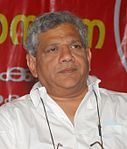| |||||||||||||||||||||||||||||||||||||||||||||||||||||||||||||||||
10 seats to the Rajya Sabha | |||||||||||||||||||||||||||||||||||||||||||||||||||||||||||||||||
|---|---|---|---|---|---|---|---|---|---|---|---|---|---|---|---|---|---|---|---|---|---|---|---|---|---|---|---|---|---|---|---|---|---|---|---|---|---|---|---|---|---|---|---|---|---|---|---|---|---|---|---|---|---|---|---|---|---|---|---|---|---|---|---|---|---|
| |||||||||||||||||||||||||||||||||||||||||||||||||||||||||||||||||
 | |||||||||||||||||||||||||||||||||||||||||||||||||||||||||||||||||
Elections were held in India on 21 July and 8 August 2017 as nomination contests by state legislators routinely for ten members of the Rajya Sabha across three states, replacing those who retired in July and August 2017.[1] The State Legislatures which contribute in this six-year minor elections/nomination cycle are Goa, Gujarat and West Bengal. The mechanism is the single transferable vote (STV) among legislators, meaning nominations may be unopposed contests (commonly in states with an absolute majority for a particular party in its legislative, public elections). The open ballot is used rather than secret ballot, allowing public scrutiny.
The year also saw five by-elections one of which saw a state's co-representative change, owing to a change in the make-up of the relevant legislature in the intervening three years.
The 2017 six-yearly cycle is of great importance to Goa, where its sole Rajya Sabha member is chosen by its current legislators; 3 of 11 members for Gujarat and 6 of 16 members are also so elected (see cross-party nomination contests) in this cycle.
The outcome in party terms, which tends to reflect the current popular political make-up of the relevant legislatures, was primarily no change (12 of the 15 seats involved in 2017). The other three seats to reflect state political changes were two intervening sufficient mathematical state gains in support for the VJP at state elections, at the expense of the INC entitling two VJP nominations rather than INC and one state gain in support (sufficient proportional representation swing) for the AITC which had cost the Communist Party of India (Marxist), specifically in West Bengal.
- ^ "Statewise Retirement". 164.100.47.5. Retrieved 12 June 2016.



